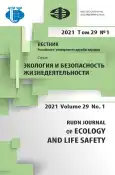Current condition of populations and spatial-environmental features of habitats of russet ground squirrel Spermophilus major
- Authors: Tukhbatullin A.R.1, Brandler O.V.1
-
Affiliations:
- Koltzov Institute of Developmental Biology of the Russian Academy of Sciences
- Issue: Vol 29, No 1 (2021)
- Pages: 7-22
- Section: Ecology
- URL: https://journal-vniispk.ru/2313-2310/article/view/323863
- DOI: https://doi.org/10.22363/2313-2310-2021-29-1-7-22
- ID: 323863
Cite item
Full Text
Abstract
The russet ground squirrel (Spermophilus major ) is known in the literature as a numerous widespread ground squirrel species. In recent decades, a decline in its abundance was found in some parts of its range. We have assessed the condition of this species in most parts of its distribution area based on our observations and interviews with local people. Spatial, landscape and vegetation cover parameters of S. major settlements have been studied. The research results showed a decline in the number, disappearance of settlements and a decrease in suitable habitats for this species. Small and medium-sized settlements with relatively low density of burrows, associated with low grass meadow communities typical for pastures and cattle grazing, prevail among the found settlements. One of the main factors for the decline in the number and disappearance of settlements of russet ground squirrel is, apparently, a decrease of pasture cattle grazing intensity. The continuing trend of degradation of pasture ecosystems may pose a threat to the existence of this species.
About the authors
Andrei R. Tukhbatullin
Koltzov Institute of Developmental Biology of the Russian Academy of Sciences
Author for correspondence.
Email: mne_x@mail.ru
junior researcher
26 Vavilova St, Moscow, 119334, Russian FederationOleg V. Brandler
Koltzov Institute of Developmental Biology of the Russian Academy of Sciences
Email: rusmarmot@yandex.ru
PhD, leading researcher
26 Vavilova St, Moscow, 119334, Russian FederationReferences
- Ognev SI. Animals of the USSR and adjoining countries (vol. 5). Moscow, Leningrad: Izdatel’stvo AN USSR Publ.; 1947. (In Russ.)
- Afanasev AV, Sludskiy AA, Korelov MN, Bazhanov VS, Strautman EI. Animals of Kazakhstan. Almaty: Izdatel'stvo AN Kaz. SSR Publ.; 1953. (In Russ.)
- Nikolskii AA. On the problem of boundary between the ranges of Citellus maior and C. erythrogenys (rodentia, sciuridae) in Northern Kazakhstan. Zoologicheskiy Zhurnal. 1984;63(2):256-262. (In Russ.)
- Afonin AN, Grin SL, Dzyubenko NI, Frolov AN. (eds.) Interactive agricultural ecological atlas of Russia and neighboring countries. Internet-version 2.0. 2008. Available from: http:www.agroatlas.ru (accessed: 01.12.2020).
- Nekrasov ES. Russet ground squirrel in the forests of the Urals. Priroda. 1971;(2):122-123. (In Russ.)
- Popov VA. Mammals of the Volga-Kama region: Insectivorous, Cheiroptera, Rodents. Kazan: Izdatel’stvo AN USSR Publ.; 1960. (In Russ.)
- Rudi VN. On the distribution of the russet ground squirrel in the South Urals. Biologicheskie Nauki. 1984;(7):52-56. (In Russ.)
- Ermakov OA, Titov SV. Dynamics of Spermophilus major (Rodentia, Sciuridae) range boundaries in the Volga River region. Zoologicheskiy Zhurnal. 2000;79(4):507-509. (In Russ.)
- Kuzmin AA, Shmyrov AA, Titov SV. Russet ground squirrel (Spermophilus major Pall.) on the right Bank of the Volga: current state and distribution. Izvestiya PGPU imeni V.G. Belinskogo. 2011;(25):214-219. (In Russ.)
- Titov SV, Shmyrov AA, Kuzmin AA. Biotope principles of sympatry and interspecies hybridization in mammals (by the example of the genus Spermophilus). Biology Bulletin. 2012;39(1):36-44. http://dx.doi.org/10.1134/S1062359012010116
- Titov SV, Kuzmin AA, Zaks SS, Chernyshova OV. Species specificity of biotopic preferences as a factor in interspecific isolation in mammals (by the example of genus Spermophilus). Russian Journal of Ecosystem Ecology. 2017;2(4):1-12. (In Russ.) http://dx.doi.org/10.21685/2500-0578-2017-4-4
- Ermakov OA, Surin VL, Titov SV, Tagiev AF, Lukyanenko AV, Formozov NA. A molecular genetic study of hybridization in four species of ground squirrels (Spermophilus: Rodentia, Sciuridae). Rus. J. Gen. 2002;38(7):796-809. http://dx.doi.org/10.1023/A:1016395722664
- Spiridonova LN, Chelomina GN, Tsuda K, Yonekawa H, Starikov VP. Genetic evidence of extensive introgression of short-tailed ground squirrel genes in a hybridization zone of Spermophilus major and S. erythrogenys, inferred from sequencing of the mtDNA cytochrome b gene. Rus. J. Gen. 2006;42(7):802-809. http://dx.doi.org/10.1134/S1022795406070167
- Nekrasov EС. Density distribution of the russet ground squirrel on the northern border of the area. Ekologiya. 1970;(1):103. (In Russ.)
- Yerzhanov NT. Modern state of biodiversity of mammals of the Kazakh shallow spotter and factors that determine it. Vestnik KarGU. 2001;(3):78-91. (In Russ.)
- Skalon NV, Gagina TN. Whether to save the russet ground squirrel in Kuznetskaya steppe? Stepnoj Byulleten. 2004;(15):42-46. (In Russ.)
- Okulova NM, Grazhdanov AK, Neronov VV. Structure and dynamics of mammal communities in Western Kazakhstan. KMK Scientific Press; 2017. (In Russ.)
- Shilova SA. Abundance control and conservation of sousliks in Russia (g. Spermophilus). Arid Ecosystems. 2011;1(4):267-272. http://dx.doi.org/10.1134/S2079096111040147
- Kuznetsov BA. Mammals of Kazakhstan. Moscow: Izd. Moskovskogo Obschestva Ispytatelej Prirody Publ.; 1948. (In Russ.)
- Nekrasov ES. Biological features of a russet ground squirrel on the northern border of the area (Middle Urals) (dissertation). Sverdlovsk; 1973. (In Russ.)
- Nikolskii AA, Starikov VP. Variability of alarm call in Spermophilus major and Spermophilus erythrogenys (Rodentia, Sciuridae) within contact zone in Kurgan district. Zoologicheskiy Zhurnal. 1997;76(7):845-857. (In Russ.)
- Manly BFL, McDonald LL, Thomas DL, McDonald TL, Erickson WP. Resource selection by animals: statistical design and analysis for field studies. Springer Science & Business Media; 2007.
- Sludskiy AA, Varshavsky SN, Ismagilov MI, Kapitonov VI, Shubin IG. Mammals of Kazakhstan. Rodents (Marmots and Ground Squirrels) (AA Sludskiy, ed.). Almaty: Nauka Publ.; 1969. (In Russ.)
- Oparin ML, Oparina OS, Matrosov AN, Kuznetsov AA. Mammalian fauna dynamics in Volga-Ural interfluve steppes in the last century. Povolzhskiy Journal of Ecology. 2010;(1):71-85. (In Russ.)
- Abaturov BD. Ecological consequence of the ungulate pasturage for the semidesert ecosystems. In: Shilov IA, Alyakrinskaya IO. (eds.) Ecological Processes in Arid Biogeocenoses: XIX meetings in memory of academician V.N. Sukachev. Moscow; 2001. p. 57-83. (In Russ.)
- Dymova TV. Redistribution of ecological groups and life forms of plants of the Volga delta pastures under the influence of pasturage. South of Russia: Ecology, Development. 2009;4(1):24-29. (In Russ.) http://dx.doi.org/10.18470/1992-1098-2009-1-24-29
- Shilova SA, Savinetskaya LE, Neronov VV. Dynamics of abundance and biomass of the little ground squirrel (Spermophilus pygmaeus pall., 1778) in pasturable ecosystems of Kalmykia for the 28-years period]. Aridnye Ekosistemy. 2009;15(38):28-38. (In Russ.)
Supplementary files









